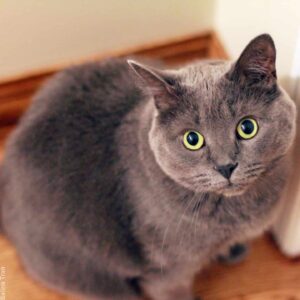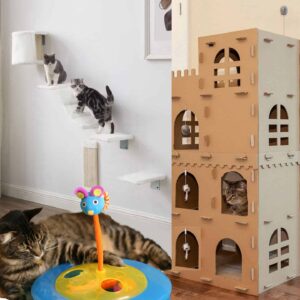Ron Hines DVM PhD
Forsaking their litter box and urinating and/or defecating in inappropriate places is the most common problem that cat owners face. For some cats, it is purely a behavioral issue. For others, there is an underlying medical cause. For a few, it’s both. With the exception of having your cat neutered and periodic vaccinations, nonmedical and medically related urination issues are at the top of the list of reasons cat owners bring their cats to veterinarians. (read here) Included in that group are kitties that inadvertently pick a wrong area in your house in which to pee and poop, and the cats that spray-mark their territory with “puffs” of urine. All are called “elimination issues”. But they represent many different underlying problems with different causes and different possible solutions. The nonmedical causes are considerably more common in multi-cat households. In single-cat homes, underlying medical issues are higher on the list.
Cats that puff or spray only their urine are marking their territory. That is a natural trait of un-neutered male cats, and, to a lesser extent, female cats as well. It is an important method of feline communication. Neutered cats are less likely to retain that inclination. Yet, urine marking is not entirely driven by your cat’s sex hormones. In multi-cat households, spraying can also be a sign of insecurity or rival dominance. Those cats usually continue to use their litter boxes too. Defecation outside of your cat’s litter box, particularly near the box, is much more likely to be due to your cat’s disapproval of litter box conditions. Most cats that squat and deposit large amounts of urine or poop were either never properly house-trained to begin with, or no longer find their litter box satisfactory for one reason or another. A lesser number have territorial issues with litter box(s) placement, or have a medical issue that require your veterinarian’s attention. In elderly cats, arthritis, joint pain and declining cognitive function enter the picture too. (read here)

Why Does My Cat Do This When It Knows How Much That Irritates Me!
Most cat owners today see their cats as friends, companions and intellectual equals. We talk to our cats – at least I do. We celebrate their birthdays. We buy them presents, we cook for them. Their pleasures are our pleasure. Be that as it may, your cat doesn’t know that its elimination issues irritate you. Your cat is not taking revenge for some previous slight. It isn’t out to get even because you went shopping and left it home alone. It isn’t doing it to seek attention or to annoy you. If you decide to look at the issue in those terms, you are not going to solve the problem, and there will be at least two unhappy individuals in your home – kitty and you.
Nature designed cats in the wild, and those that live in our homes, to use urine as their calling card. Cats are, by nature, territorial, low density creatures that hunger for a territory to call their own. (read here) And they stake out its boundaries with a puff of their urine. They use their urine to announce their identity, as a bird uses its song. And to announce their presence to other cats, and to assert themselves over any cats that might be considering commandeering their space. Without their own space, cats can become highly insecure. (read here) Scientists think that cats do the same thing when they rub against you, releasing cat-specific hormone compounds call pheromones. (read here) Glands that release those compound are found under your cat’s chin, at the base of its ears, on its forehead, cheeks and tail, as well as its rear end and paw pads. Similar pheromones are also present in your cat’s urine – imparting much of its unique smell. Those secreted from its skin have no noticeable odor to you, but are very noticeable to other cats. When you teach your cat to urinate in one small specific area, you are going against those natural, inborn instincts and relying on your cat’s penchant for cleanliness and its fastidiousness. (read here)

Is One Cat Breed Or One Sex More Likely To Have This Problem Than Another?
There might be a slight difference in your cat’s personality and toiletry habits depending on its breed. In one 2009 questionnaire, mailed to 67 Japanese veterinarians, personality traits related to inappropriate elimination were thought by those veterinarians to be the least dependent of several traits on the cat’s breed. In that, and other studies, female cats with elimination issues outnumbered neutered male cats. (read here) Looking at the records of 736 cats that arrived at the Cornell Veterinary School Clinic between 1991 and 2001, Persian cats were the breed most often associated with elimination outside of their litter box, and mixed breed, domestic short haired cats the least. Of those cats urinating outside of their litter box, 56.2% were male and 43.8% were female. Of those spraying urine, 75% were male and 25% were female. Of those pooping outside of their litter box, 65.2% were male and 34.85% were female. House soiling was diagnosed in more than half of those 736 cats. (read abstract here) or ask me for Bamberger2006.
Your Cat’s Personality
Shy, fearful cats are thought to be more likely to urinate outside of their litter boxes than outgoing, mellow, sociable, cats. They are also believed to be more prone to defecate outside of their boxes. Other personality traits, such as sociability toward feline roommates, being un-neutered, being male, or being of advanced age only seem to increase litter box fussiness. A lack of playfulness also associates with elimination issues. These traits can often be recognized even when the cat was a kitten. Those individual personality traits appear to be more important than the number of cats in your household. When it comes to where your cat chooses to urine mark, furniture (91%), sliding door & window sills where your cat can see outside the house (87%), other walls (72%), on appliances (47%), newly introduced items (23%), and cat-associated items such as the litter box itself or toys (13%) were reported. (read here & here)
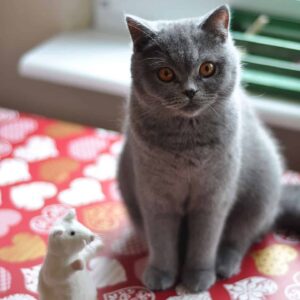
Is This Always My Cat’s Fault?
No.
As I mentioned, when your cat urinates and/or poop outside of its litter box, it can be due to something about the box or litter that displeases it. But it can also be due to a diet induced, urinary tract or other health issue. And even when your veterinarian finds that a physical health issue is present, the psychological issues and litter box etiquette I mentioned earlier can play a part in the problem as well. For reasons I do not quite understand, several studies have found that the presence of children in the home increases the likelihood of, feline litter box use issues. Some associate that with a lack of quiet, peaceful nooks where your cat can be alone when it wishes to or, perhaps, less spare time for you to clean and refill your cat’s litter box(s). Dogs in the family can also annoy your cat. It may be a perfect play time for your dog, but not for your cat. Cats rarely have the stamina of dogs when it comes to playtime. It’s not always one big, happy family, as all of you already know. Everyone needs their private space. (read here & here)

Medical Issues:
I list these medical issues second. That is because the majority of cats that are lax about peeing in the proper places do not do so due to medical issues. When you visit your doctor, he/she can probably find some minor things amiss. The same goes for veterinarians, it just as uncommon for a cat to be perfectly normal in all its laboratory test analyses and physical examination as it is for you to be. But it is natural for veterinarians like myself to dwell on the medical, rather than the psychological and environmental causes of unwanted behavior because that is the way we were trained. That’s how we make our living. That’s what we do.
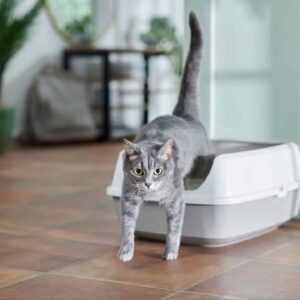
Feline Urological Syndrome (aka FUS, FLUTD, etc.)
The most common medical problem that causes cats to break their litter box training is irritation of their lower urinary tract and bladder. Consider this if your cat was using its litter box properly, but suddenly becomes lax about doing so, when you have not made other changes in your home life.
Crystals have sharp edges. In FUS, crystals are forming in your cat’s urine, causing inflammation, resulting in painful, frequent urination and the urge to go. Early in this situation, many cats get the urge to urinate in exotic places, such as your closet or bathroom sink. When you bring in a fresh urine sample, one collected no longer than an hour ago, or, better yet, expressed from your cat’s bladder at the animal hospital, and your vet or vet tech sees microscopic crystals in the sediment of that urine, your cat, most likely has a urinary tract problem. Some veterinarians insist on drawing out their urine sample with a long needle (cystocentesis). I only perform that, as physicians do, when gentle hand pressure is not sufficient to produce a urine flow (midstream clean catch) or when I plan to submit a urine sample for bacterial identification and antibiotic choice. Primary UTIs are very rare in cats that have normal anatomy. Crystaluria (urinary crystals) are considerably more common. (read here & here)
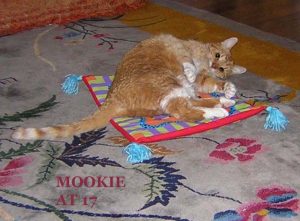
Your Cat’s Age
Senior cats like Mookie tend to be more demanding of you in their litter box cleanliness. But they might also be facing the aches of arthritis and joint pain, or have visual perception deficits (can’t see as well as they once did). (read here) In 2023, Zoetis introduced a new medication, Solensia®, to decrease the pain of arthritis and joint inflammation in older cats. You can read cat owner feedback on that product here. There are veterinarians dispensing low-dose meloxicam, an NSAID, for arthritic issues in cats, I don’t suggest that medication yet because I fear possible unwanted effects on your elderly cat’s kidneys. It has to do with how cats metabolize all NSAIDs, specifically a cat’s low level of CYP1A/ P450. Perhaps at a very low dose that is not an issue. Time will tell.

Other Medical Problems:
There are three other common diseases of cats that can also cause them to urinate in the wrong areas. They are all diseases that cause your pet to drink more – and consequently, to urinate more. They are hyperthyroidism, chronic kidney disease and diabetes. All three are identifiable through blood and urine tests your veterinarian will perform “in house” or send to a central laboratory.
In new arrival cats, sudden diet changes or a long-time cat’s decision to maraud your trash or eat your dog’s food can cause colic, sudden loose stools or diarrhea. In those situations, cats are quite likely to soil the house. Other cats develop inflammatory bowel syndrome (IBD) or triad disease that change their elimination habits. Occasionally, a cat born without a tail (e.g. Manx) will also have difficulty controlling its bladder and bowel function. That genetic trait is for spinal abbreviation. When too intense (such as a tailess X tailess mating), the nerves that control bladder contraction and the anal sphincter do not function properly.
Sex hormones play a large part in influencing your cat’s behavior. That is why un-neutered male, and occasionally intact female, cats are more likely to urine mark their homes. Occasionally, male cats are born cryptorchid with one or both of their testicles undescended from within their abdomens. If a retained testicle is left in a cat, it will eventually begin to spray, just like an ordinary un-neutered tomcat would. If your “neutered” male cat has the suspicious jowls and tail of a tomcat, it needs a testosterone level check. Perhaps one of its testicles was undescended at the time it was neutered. Or, perhaps it was bilaterally cryptorchid and just assumed to have been neutered. “Spayed” female cats that continue to go through overly affectionate periods during which they spray urine also need a hormone analysis to detect ovarian fragments that may have been inadvertently missed during their spay surgery. A loss of male or female traits after an injection of a GnRH analogue medication is one non-surgical way to confirm that a cat retains gonadal remnants.
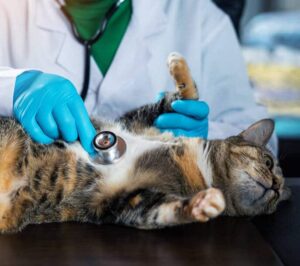
Well, My Vet Gave My Cat A Clean Bill Of Health – What Should I Do Now?
Many cats dislike seeing, hearing, or smelling the presence of cats that are not accepted family members. So the first thing I would do, in addition to what I mentioned earlier abut litter box cleanliness and placement, is to keep strange cats out of your cats’ environment. If the problem persists, find ways to give each of your cat’s its own space property. If the problem came on suddenly, return things as best you can to how they were before the problem began. (read here)
Consider Enriching Your Cat’s Environment
One way to neutralize stress in a cat’s life is to provide it with pleasant distractions. Try adding more scratching posts, catnip-filled toys, and sunny, basking areas. Fishbowls, ping-pong balls, squeaky toys, dripping water, jars of bugs and time in a safe outdoor enclosure are all things that many cats enjoy. Sprout gardens are great entertainment for cats – just be sure to use edible seeds from the supermarket and not treated seed from a garden or lawn supply. Presenting food and treats in challenging ways keep cats occupied and stress low. Puzzle feeders keep cats challenged and lessens boredom.

Are There Medications That Might Help?
Yes. But none are as effective as changing the conditions that caused your cat to develop this problem in the first place. In that respect, effective medications are cover-ups. In most instances, the problem will reappear when you discontinue administering these medications.
The one most likely to have no negative side effects is Feliway®. It is sold as a cat feel-good pheromone, but its active ingredient is said to actually be valerian. Valerian contains some compounds similar to those in catnip. (read here) But it also contains numerous other compounds with sedative potential. (read here) One study did not find Feliway-type products very helpful in combating stress in cats in shelter situations (read here). But give it a try anyway.
Your other choices are all true pharmaceutical medications with known actions and side effects. None of them I know of are FDA-approved for this use in cats. The most common ones veterinarians dispense are diazepam (Valium®), fluoxetine (Reconcile®, Prozac®), buspirone and clomipramine. All of them have helped end problem behaviors in certain cats, but not in others. All can have problematic side effects. None should be given without consulting your veterinarian.
Medications that affect behavior, can also affect your cat’s ability to learn. So, it is best not to give them when you are attempting behavior and environmental changes to solve the problem. Use them only when no other options remain available. They can all take considerable time to show positive effects. You will need patience. If the cat improves on these medications without serious side effects, many continue the medication for 4–6 months and then gradually withdraw them.
You are on the Vetspace animal health website
Visiting the products that you see displayed on this website help pay the cost of keeping these articles on the Internet.

